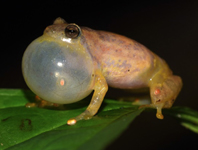Abstract
Blattophila peregrinata Carreno, 2017 (Nematoda: Oxyuridomorpha: Thelastomatidae) is proposed as a junior synonym of Suifunema peregrinatum (Carreno, 2017) n. comb., based on the revision of the type material of S. caudelli Chitwood, 1932, the type and only species of the genus. The revision permitted the emendation of some features of the original descriptions, namely the position of the nerve ring at level of the corpus instead the isthmus and the female genital tract didelphic-prodelphic instead didelphic-amphidelphic. The males of S. peregrinatum n. comb. are the only ones known for the genus. Thus, an amended generic diagnosis is given, including information on the males. Both S. peregrinatum n. comb. and S. caudelli differ by having a more slender body, a longer tail, and the vulva farther from the anterior end in the former. S. peregrinatum n. comb. is recorded for the first time from Pycnoscelus indicus Fabricius, 1775 (Blattodea: Blaberidae) from Japan. The specimens from Japan are morphologically consistent with other populations of the species from the USA and the Galapagos Islands of Ecuador. Only some morphometrics vary slightly, but these are within the range of the species. The phylogenetic position of the genus among the family Thelastomatidae is discussed, including sequences of the D2-D3 LSU rDNA of specimens from both the type population (Ohio, USA) and Japan.
References
Adamson, M.L. & Van Waerebeke, D. (1992) Revision of the Thelastomatoidea, Oxyurida of invertebrate hosts I. Thelastomatidae. Systematic Parasitology, 22, 111–130.
https://doi.org/10.1007/BF00009911
Baruš, V. & Koubková, B. (2002) The first species of Thelastoma Leidy, 1849 (Nematoda: Thelastomatidae) parasitising the scorpion Euscorpius italicus (Chactidae: Scorpionidea). Systematic Parasitology, 53, 141–146.
https://doi.org/10.1023/A:1020470108631
Bell, W.J. (1981) The Laboratory Cockroach. Experiments in Cockroach Anatomy, Physiology and Behavior. Chapman and Hall, London, 161 pp.
https://doi.org/10.1007/978-94-011-9726-7
Capella-Gutiérrez, S., Silla-Martínez, J.M. & Gabaldón, T. (2009) trimAl: a tool for automated alignment trimming in large-scale phylogenetic analyses. Bioinformatics, 25, 1972–1973.
https://doi.org/10.1093/bioinformatics/btp348
Carreno, R.A. (2017) New species of Hammerschmidtiella Chitwood, 1932, and Blattophila Cobb, 1920, and new geographical records for Severianoia annamensis Van Luc & Spiridonov, 1993 (Nematoda: Oxyurida: Thelastomatoidea) from Cockroaches (Insecta: Blattaria) in Ohio and Florida, U.S.A. Zootaxa, 4426 (3), 429–441.
https://doi.org/10.11646/zootaxa.4226.3.6
Chitwood, B.G. (1932) A synopsis of the nematodes parasitic in insects of the family Blattidae. Zeitschrift für Parasitenkunde, 5, 14–50.
https://doi.org/10.1007/bf02120633
Farooqui, M.N. (1967). On a known and some new species of insect nematodes. Zoologischer Anzeiger, 178, 276–296.
Jex, A.R., Schneider, M.A., Rose, H.A. & Cribb, T.H. (2005) The Thelastomatoidea (Nematoda: Oxyurida) of two sympatric Panesthiinae (Insecta: Blattodea) from southeastern Queensland, Australia: taxonomy, species richness and host specificity. Nematology, 7 (4), 543–575.
https://doi.org/10.1163/156854105774384741
Lee, D.L. (1974) On the occurrence of dimorphic males in Thelastoma attenuatum Leidy, 1849. Helminthologia, 15, 839–844.
Mimioğlu, M.M. & Şahin, Ý. (1975) A parasitological study on cockroaches (Blattidae). Microbiyoloji Bülteni, 10, 17–25. [in Turkish]
Mohagan, A.B. & Spiridonov, S.E. (2017) Davenema obtusum gen. sp. nov. the new thelastomatid (Nematoda, Thelastomatoidea) from littoral cockroaches of Camiguin Island, Philippines. Russian Journal of Nematology, 25 (1), 61–69.
Morffe, J. & Hasegawa, K. (2017) Morphological and molecular characterization of Travassosinema claudiae n. sp. (Oxyuridomorpha: Travassosinematidae) from the Japanese millipede Parafontaria laminata (Attems, 1909) (Polydesmida: Xystodesmidae). Zootaxa, 4282 (1), 166–178.
https://doi.org/10.11646/zootaxa.4282.1.10
Nunn, G.B. (1992) Nematode molecular evolution. Ph.D. University of Nottingham, Nottingham, 187 pp.
Ozawa, S., Morffe, J., Vicente, C.S.L., Ikeda, K., Shinya, R. & Hasegawa, K. (2016) Morphological, molecular and developmental characterization of the thelastomatid nematode Thelastoma bulhoesi (de Magalhães, 1900) (Oxyuridomorpha: Thelastomatidae) parasite of Periplaneta americana (Linnaeus, 1758) (Blattodea: Blattidae) in Japan. Acta Parasitologica, 61 (2), 241–254.
https://doi.org/10.1515/ap-2016-0034
Ozawa, S., Vicente, C.S.L., Sato, K., Yoshiga, T., Kanzaki, N. & Hasegawa K. (2014) First report of the nematode Leidynema appendiculata from Periplaneta fuliginosa. Acta Parasitologica, 59 (2), 219–228.
https://doi.org/10.2478/s11686-014-0230-6
Rambaut, A., Suchard, M.A., Xie, W. & Drummond, A.J. (2003) Tracer. Version 1.6. Available from: http://beast.bio.ed.ac.uk/Tracer/ (accessed 12 October 2016)
Ronquist, F., Teslenko, M., van der Mark, P., Ayres, D.L., Aaron, D., Höhna, S., Larget, B., Liu, L., Suchard, M.A. & Huelsenbeck, J.P. (2012) MrBayes 3.2: efficient Bayesian phylogenetic inference and model choice across a large model space. Systematic Biology, 61 (3), 539–542.
https://doi.org/10.1093/sysbio/sys029
Sinnott, D., Carreno, R.A. & Herrera, H. (2015) Distribution of thelastomatoid nematodes (Nematoda: Oxyurida) in endemic and introduced cockroaches on the Galápagos Island archipelago, Ecuador. Journal of Parasitology, 101 (4), 445–457.
https://doi.org/10.1645/15-721.1
Spiridonov, S.E. (1984) New oxyurid species from the intestine of Rhinocricus sp. Trudy Zoologicheskogo lnstituta, 126, 33–49. [in Russian]
Spiridonov, S.E. & Guzeeva, E.A. (2009) Phylogeny of nematodes of the superfamily Thelastomatoidea (Oxyurida) inferred from LSU rDNA sequence. Russian Journal of Nematology, 17 (2), 127–134.
Sriwati, R., Ozawa, S., Morffe, J. & Hasegawa, K. (2016) First record of Hammerschmidtiella diesingi (Hammerschmidt, 1838) (Oxyuridomorpha: Thelastomatidae) parasite of Periplaneta americana (Linnaeus, 1758) (Blattodea: Blattidae) in Japan, morphological and molecular characterization. Acta Parasitologica, 61 (4), 720–728.
https://doi.org/10.1515/ap-2016-0101
Tamura, K., Stecher, G., Peterson, D., Filipski, A. & Kumar, S. (2013) MEGA6: Molecular Evolutionary Genetics Analysis version 6.0. Molecular Biology and Evolution, 30, 2725–2729.
https://doi.org/10.1093/molbev/mst197
Zervos, S. (1987) Protrellus dalei n. sp., Blatticola barryi n. sp., and Suifunema mackenziei n. sp., thelastomatid nematodes from New Zealand cockroaches. New Zealand Journal of Zoology, 14, 239–250.
https://doi.org/10.1080/03014223.1987.10422994

